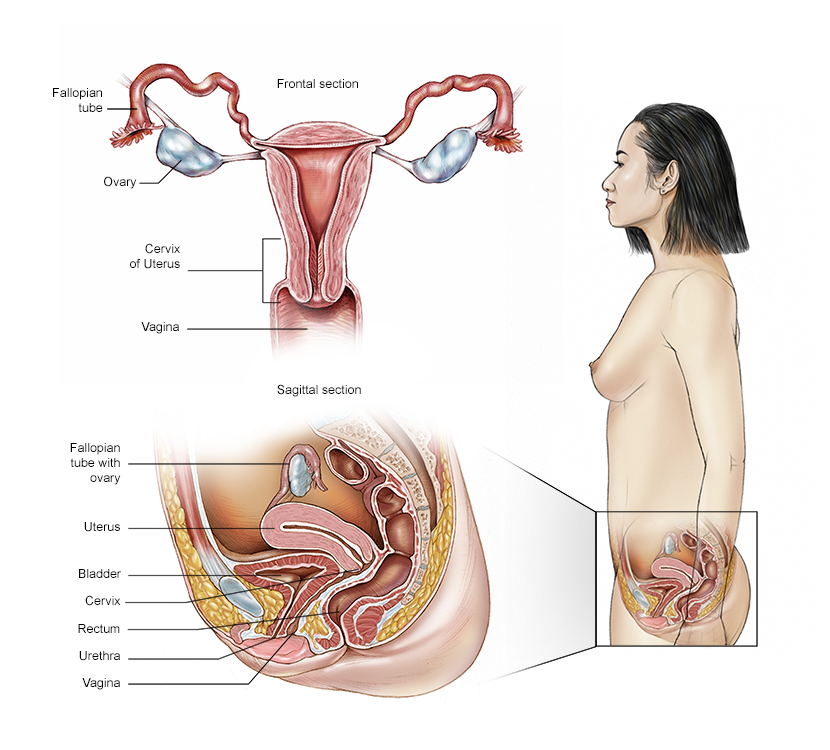Approved by the Cancer.Net Editorial Board, 12/2022
About the uterus
The uterus is a hollow, pear-shaped organ located in the pelvis between the bladder and rectum. It is the largest organ of the female reproductive system. The uterus is also called the womb or endometrium. It is where a baby grows during pregnancy. The uterus has 3 sections:
- The cervix, which is the narrow lower section
- The isthmus, which is the broad section in the middle
- The fundus, which is the dome-shaped top section
The uterus is made up of 3 layers: the endometrium (inner layer that lines the inside of the uterus), the myometrium (the thickest layer composed almost entirely of muscle), and the serosa (the thin outer lining of the uterus).
During the childbearing years, the body’s ovaries typically release an egg every month, and the lining of the endometrium grows and thickens in preparation for pregnancy. If pregnancy doesn’t occur, this endometrial lining sheds through the vagina, a process known as menstruation. This process continues to occur each month until menopause, when the ovaries stop releasing eggs and producing female hormones.

About uterine cancer
Uterine cancer, also called endometrial cancer, is the most common cancer occurring within the female reproductive system. Uterine cancer begins when healthy cells in the uterus change and grow out of control, forming a mass called a tumor. A tumor can be cancerous or benign. A cancerous tumor is malignant, meaning it can grow and spread to other parts of the body. A benign tumor can grow but generally will not spread to other body parts.
Noncancerous conditions of the uterus include:
- Fibroids: Benign tumors in the muscle of the uterus
- Benign polyps: Abnormal growths in the lining of the uterus
- Endometriosis: A condition in which endometrial tissue, which usually lines the inside of the uterus, is found on the outside of the uterus or other organs
- Endometrial hyperplasia: A condition in which there is an increased number of cells and glandular structures in the uterine lining. Endometrial hyperplasia can have either normal or abnormal cells and simple or complex glandular structures. The risk for developing cancer in the lining of the uterus is higher when endometrial hyperplasia has atypical cells and complex glands.
There are 2 major types of uterine cancer:
- Adenocarcinoma. This type makes up the majority of uterine cancers. It develops from cells in the endometrium or uterine lining. This cancer is commonly called endometrial cancer. One common endometrial adenocarcinoma subtype is called endometrioid carcinoma. Treatment for this type of cancer varies depending on the grade of the tumor, how far it goes into the uterus, and the stage or extent of the disease (see Stages and Grades). Less common subtypes of uterine adenocarcinomas include serous, clear cell, and carcinosarcoma. Carcinosarcoma is a mixture of adenocarcinoma and sarcoma (see below).
- Sarcoma. This type of uterine cancer develops in the supporting tissues of the uterine glands or in the myometrium, which is the uterine muscle. Sarcoma accounts for about 2% to 4% of uterine cancers. Subtypes of endometrial sarcoma include leiomyosarcoma, endometrial stromal sarcoma, and undifferentiated sarcoma. Learn more about sarcoma.
Cancer confined to the uterine cervix is treated differently from uterine cancer. Learn more about cervical cancer in a separate guide on this website. The rest of this section covers the more common endometrial (adenocarcinoma) cancer.
About genetics and family history of uterine cancer
A higher risk for uterine cancer can be inherited, meaning it is passed from generation to generation, or it may skip a generation to appear in the next. This happens in about 5% of uterine cancer cases. The syndrome most commonly associated with inherited uterine cancer is called Lynch syndrome. Lynch syndrome is also associated with several other types of cancer, including types of colon, kidney, bladder, and ovarian cancers.
People with cancer can be screened for signs of Lynch syndrome, which can then be confirmed with genetic testing. If a person is found to have Lynch syndrome, family members may wish to be tested, too. People affected by Lynch syndrome should tell their doctors so they can receive increased screening for Lynch-associated cancers, such as more frequent colonoscopies. Other family members may consider preventive surgery for uterine and ovarian cancers.
It is recommended that all patients with endometrial cancer are screened for Lynch syndrome. Ask your doctor if you need additional testing, including for other possible inherited conditions. Learn more about Lynch syndrome and genetic testing in other sections of this website.